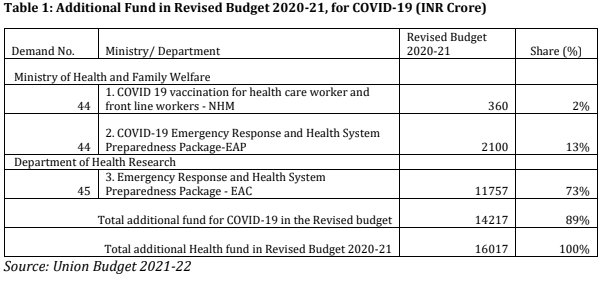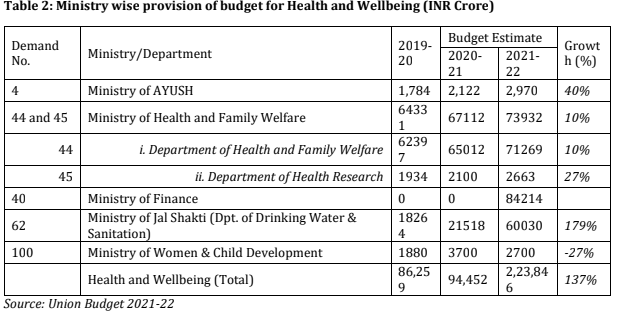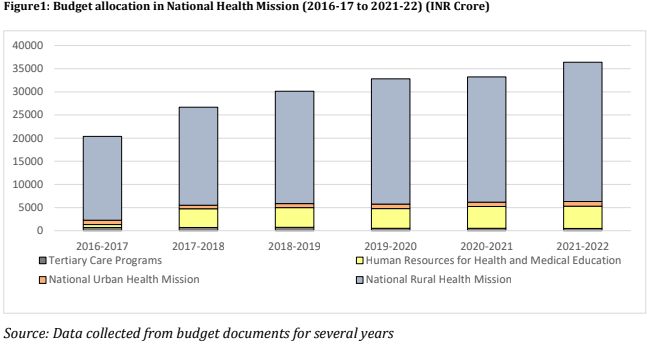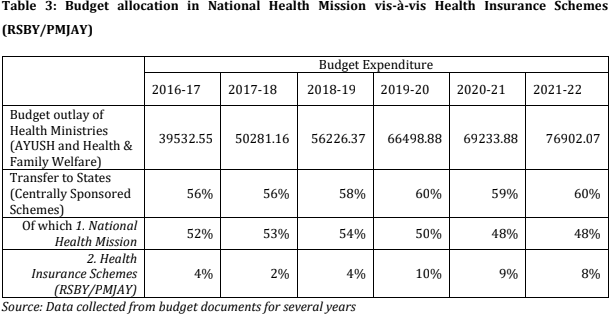A 137% Hike in Health Budget? Here Are the Correct Numbers
The COVID-19 pandemic has taken a toll on economies everywhere, and India is no exception. The ongoing pandemic has also exposed the critical state of India’s healthcare system. Both the Economic Survey 2020-21 and the report of the 15th Finance Commission say there is a need to enhance public investment in healthcare.
Over the last year, the Government of India took measures to control the damage caused by COVID-19 and to boost the economy. This reflects in the Revised Estimates (RE) for 2020-21 and the budget allocations for 2021-22: there is a 13% increase in the total federal government expenditure in the RE for 2020-21 over the budgeted estimates.
Four per cent of this addition in the RE is due to the additional fund requirements of the health ministries—AYUSH, and Health and Family Welfare.
Estimates show that 89% of the extra funds allotted in the revised health budget for 2020-21 are for COVID-19 management (See Table 1).

The stated goal of the government is to provide 2.5% of the GDP for health by 2025. The Economic Survey for 2020-21 demonstrates that up-scaling government health expenditure from 1% to 2.5-3% of the GDP can potentially reduce the share of out-of-pocket spending on health care (in the total health expenditure of the country) from 65% to 30%.
The 15th Finance Commission also acknowledges the historically low spending on public health in India.
The allocation of Rs.2,23,846 crore on “Health and Wellbeing” has been placed as first among the six pillars of the Union Budget 2021-22. Finance Minister Nirmala Sitharaman said in her speech that compared to the previous budget, this amount is an increase of 137% in the budget for health and wellbeing.
Several points need to be understood before we praise this announcement.
First, unlike her predecessors, Sitharaman has adopted a border definition of what constitutes a “health budget”, by incorporating “nutrition” and “water supply and sanitation” to the amount managed by the AYUSH and Health and Family Welfare ministries.
In her previous budget speech (in 2020-21), she had taken only the budget outlay of the AYUSH and Health and Family Welfare ministries as a part of the health spending.
Whether the budgeted outlay on water supply and nutrition fall into the domain of health care spending is debatable. According to the System of Health Account (SHA) framework, nutrition, water supply, and sanitation, although important, cannot be counted as a part of the healthcare expenditure. [SHA is a globally-accepted standard to systematically describe and report financial flows related to healthcare across countries. It has been developed by the WHO, OECD, and Euro Stat.]
Table 2 shows the ministry-wise provisions in the budget for “health and wellbeing”. The AYUSH and Health and Family Welfare ministries together will manage only 34% of the amount that has been budgeted for health and wellbeing in 2021-22.
In addition, 38% of the total budgeted amount for health and wellbeing is the “Finance Commission Grants”, which will be transferred directly to states, routed through the Ministry of Finance. An exact amount of Rs.35,000 crore of these “Finance Commission Grants” have been allocated for COVID-19 vaccination.

A new centrally-sponsored scheme (CSS), called the “Pradhan Mantri Atmanirbhar Swasth Bharat Yojana”, with an outlay of Rs.64,180 crore over the next six years has been mentioned in the budget speech. However, no expenditure head has been specified for this new scheme in Union Budget 2021-22.
The Economic Survey for 2020-21 discussed in detail the impact of schemes such as Ayushman Bharat on improving health indicators in several states. It is mentioned that India’s health system needs to be strengthened to fight a public health crisis in the future and that the National Health Mission, along with Ayushman Bharat, contributed to this mission.
There is a 10% increase in the 2021-22 budget allocation for the National Health Mission (including “Ayushman Bharat Health and Wellness Centres”) over the previous year’s allocation. However, the budget allocation for Ayushman Bharat—Pradhan Mantri Jan Arogya Yojana (PMJAY) for 2021-22 remained the same as in the previous year.
Figure 1 shows the budget allocation for the National Health Mission from 2016-17 to 2021-22 across its components. Apart from the National Rural Health Mission, there has been no significant increase in the budget allocation over the years.

Further analysis reveals that the hike in components related to strengthening the health system is not only small, but there is also a rerouting of the health funds to an insurance-based system.
While the share of the National Health Mission in the funds allocated to the AYUSH and Health and Family Welfare ministries has reduced from 54% in 2018-19 to 48% in 2021-22, the share of health insurance schemes (RSBY/PMJAY) in the funds allocated to these two health Ministries has increased from 4% to 8% during the same years (see Table 3).

Therefore, the much-talked-about 137% growth in the recent Union health budget is driven by the Finance Commission grants, routed through the Ministry of Finance, and a whopping increase in the budget outlay for water supply and sanitation.
It is important to note that the outlay for nutrition, which is managed by the Ministry of Women and Child Development, has seen significant negative growth of minus 27% in this budget, as compared to the previous one.
If we now consider the outlay only for the two health ministries, the Union health budget has increased by 10% between 2020-21 and 2021-22. The growth had been 4% between 2019-20 and 2020-21.
Given the prevailing macroeconomic uncertainty, this 10% expansion of the health budget is impressive but the hype about 137% hike in health spending in the Union Budget does not reflect the true scenario.
“Health and wellbeing”, which is inclusive of health, drinking water, sanitation, and nutrition, is accruing only 1% of the GDP and 6% of the total budget in 2021-22.
However, if we consider only the budgeted outlay of the two health ministries, the Finance Commission grants for health and COVID-19 vaccination, then the expenditure on these two ministries remains only at 0.56% of the projected GDP for 2021-22, and 4% of the total budget expenditure.
Though the importance of strengthening the health system is repeatedly emphasised in the Economic Survey, this does not reflect very much in the allocations that have been made in this budget.
At the same time, although the Economic Survey acknowledges that the unregulated private sector, which is a major part of the insurance-based healthcare system, is a source of market failure—yet there is a sneaky shift from a tax-financed to an insurance-based system.
This is happening while India is still struggling with the adverse effects of the unregulated private sector on healthcare, and with the medical inflation that took place during the pandemic.
Pritam Datta is a fellow at the National Institute of Public Finance and Policy (NIPFP), New Delhi and Chetana Chaudhuri is a senior research associate at the Public Health Foundation of India (PHFI), Gurgaon. The views are personal
Get the latest reports & analysis with people's perspective on Protests, movements & deep analytical videos, discussions of the current affairs in your Telegram app. Subscribe to NewsClick's Telegram channel & get Real-Time updates on stories, as they get published on our website.
























